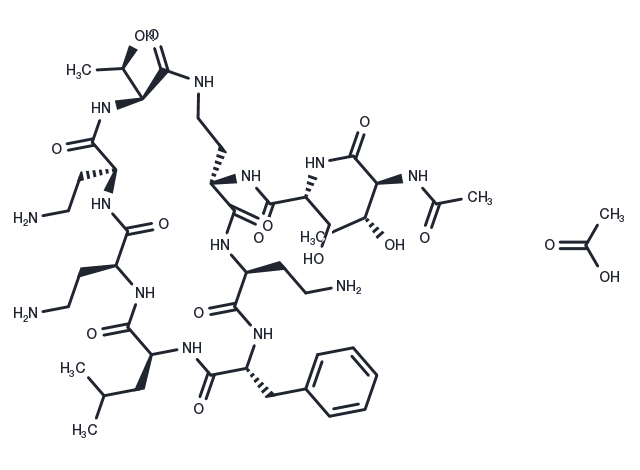store at low temperature,keep away from moisture
Powder: -20°C for 3 years | In solvent: -80°C for 1 year

SPR741 acetate is a cationic peptide derived from polymyxin B. It exhibits antimicrobial activity against gram-negative bacteria by inhibiting severe gram-negative bacterial sensory by increasing the permeability of the outer membrane of gram-negative bacteria.SPR741 acetate is often used in conjunction with antibiotics for the treatment of a number of diseases.

| Pack Size | Availability | Price/USD | Quantity |
|---|---|---|---|
| 1 mg | In stock | $ 183.00 | |
| 5 mg | In stock | $ 465.00 | |
| 10 mg | In stock | $ 633.00 | |
| 25 mg | In stock | $ 987.00 | |
| 50 mg | In stock | $ 1,360.00 | |
| 100 mg | In stock | $ 1,830.00 |

| Description | SPR741 acetate is a cationic peptide derived from polymyxin B. It exhibits antimicrobial activity against gram-negative bacteria by inhibiting severe gram-negative bacterial sensory by increasing the permeability of the outer membrane of gram-negative bacteria.SPR741 acetate is often used in conjunction with antibiotics for the treatment of a number of diseases. |
| In vitro | SPR741 acetate potentiates antibiotics ,SPR741 acetate are substrates of the AcrAB-TolC efflux pump in E. coli, effectively circumventing the contribution of this pump to intrinsic antibiotic resistance. The intrinsic resistance of E. coli to certain antibiotics that is mediated by both the outer membrane and the AcrAB-TolC efflux system can be overcome, or circumvented, by combining the antibiotic with SPR741 acetate but that potentiation of intrinsic resistance due primarily to efflux may be limited.[1] |
| In vivo | SPR741 acetate has the ability to permeabilize the outer membrane of Gram-negative bacteria, thus makeing them sensitive to hydrophobic antibiotics. SPR741 acetate has a significantly safety profile of compared to that of polymyxin B, which suffers severe, dose-limiting nephrotoxicity in humans. Polymyxin B exhibited nephrotoxicity at a far-lower exposure-normalized dose than SPR741 acetate in multiday rodent and nonhuman primate studies.[1] |
| Synonyms | SPR741 acetate, NAB741 acetate, SPR741 acetate (1179330-52-9 free base) |
| Molecular Weight | 1052.18 |
| Formula | C46H77N13O15 |
| CAS No. | T12992 |
store at low temperature,keep away from moisture
Powder: -20°C for 3 years | In solvent: -80°C for 1 year
DMSO: 117.0 mg/mL (111.2 mM), Sonication is recommended.
You can also refer to dose conversion for different animals. More
bottom
Please see Inhibitor Handling Instructions for more frequently ask questions. Topics include: how to prepare stock solutions, how to store products, and cautions on cell-based assays & animal experiments, etc.
SPR741 acetate T12992 Microbiology/Virology Antibacterial 1179330-52-9 NAB-741 Acetate NAB741 Acetate NAB 741 Acetate NAB741 acetate SPR741 acetate (1179330-52-9 free base) SPR 741 Acetate SPR-741 Acetate SPR741 Acetate 1179330-52-9 free base inhibitor inhibit
